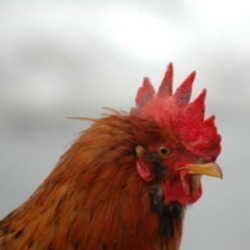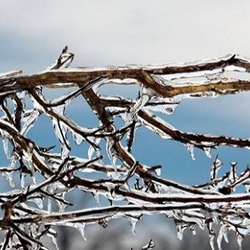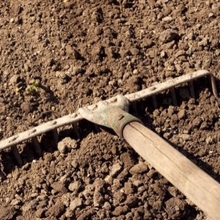People have always sought to predict the weather, especially during planting and harvesting times. The weather vane or wind vane, able to convey at a glance the direction of the wind, began as a functional and ever-ready weather tool. Over the centuries, weather vanes came to reflect the beliefs and livelihoods of the people who worked or worshipped beneath them. Although today we're more likely to turn to the Weather Channel for our forecasts, many of us still enjoy weather vanes as ornaments and as reminders of our country's beginnings.
Weather Vane Workings
The weather vane turns freely on a fixed vertical rod, and is designed to point into the wind. In order to function correctly as a directional device, the weather vane ornament must have equal mass but an unequal area on either side of the center. This allows the point of least resistance to always face into the wind. Weather vane crafters might also add the directional letters "N", "S", "E" and "W" to the rod. These fixed cardinal points made it easy for a viewer to tell at a glance whether the wind blew from the north, south, east or west.
Weather Vane History
The earliest documented weather vane was built atop the Tower of the Winds in first century Athens, Greece, possibly by the astronomer Andronicus. This weather vane bore the body of a man and the tail of a fish in honor of Triton, Greek god of the sea, a reflection of the ancients’ belief that the winds originated from divine powers. The Vikings crafted bronze into quadrant-shaped directional devices for their ships, allowing them to navigate even out of sight of land. These weather vanes were often adorned with the shapes of creatures from Norse mythology, and still decorate churches and other buildings today throughout Sweden and Norway.
 |  |
| An 18th-century reconstruction of the 1st century Tower of the Winds | Viking weather vane in Gamla Uppsala Museum, Uppsala, Sweden |
The history of the word “vane” provides us a glimpse into the functions of the first weather vanes. Scholars believe "vane" derives from the Saxon word “fane,” or “flag.” Fabric flags fluttered from early medieval towers, allowing archers to improve their accuracy by monitoring wind direction. The flags were eventually replaced by more durable metal wind indicators, which often took the shape of the property owner’s coat of arms.
Weather Vanes in America
 |  |
| The "Dove of Peace" at Mt. Vernon | Grasshopper weather vane atop Faneuil Hall |
The earliest documented American weather vane maker was Shem Drowne, a colonial Massachusetts deacon, coppersmith and tinplate worker. He created the grasshopper weather vane decorating Faneuil Hall, a Boston building today considered a U.S. National Historic Landmark. A complement to the grasshopper weather vane flying above the Royal Exchange in London, Boston’s matching weather vane was intended to symbolize the city’s financial leadership in the New World. Drowne is also responsible for the banner-shaped vane standing atop the Old North Church (made famous as the site of Paul Revere’s memorable “one if by land, two if by sea” signal).
George Washington's Weather Vane
Upon the completion of the Revolutionary War, George Washington turned his attention to the details of his property on the shore of the Potomac River. He sent this request to Philadelphia architect Joseph Rakestraw: "I should like to have a bird (in place of the Vain) with an olive branch in its Mouth." This beautiful “dove of peace” weather vane, crafted from copper and gilded with gold leaf, was installed in 1787 and provided the finishing touch to the cupola of Washington’s beloved Virginia home, Mount Vernon.
Weather Vane Types
While the weather forecasting needs of an entire European community might be served by one vane placed on the highest building or church tower in town, the early population of the U.S. was spread over a much wider area, meaning that every homestead or barn might display its own weather vane. These vanes became a form of folk art that reflected the landscape in which it was created. Thus, weather vanes in coastal towns often had a seafaring theme, and might be shaped like a ship, whale or gull. Farm animals such as roosters, pigs and cows were popular subjects in rural areas, while horses, arrows and Indian figureheads predominated in the West. Patriotic fervor made the eagle, symbol of the newly formed republic, a widely popular rooftop decoration throughout the country.
 |  |  |
 |  |  |
Weather Vanes Today
The earliest American weather vanes were hammered or forged by hand from various types of metal, or else whittled from wood and painted by hand. Later, factories began mass producing weather vanes, which reached their peak of popularity in Victorian times. You can view fine examples of early weather vanes in museums such as New York’s American Folk Art Museum, Vermont’s Shelburne Museum, and the Henry Ford Museum in Dearborn, Michigan. Numerous manufacturers still make weather vanes today, offering historical reproductions as well as contemporary depictions of all sorts of interests and hobbies. You can even commission your own personalized design to decorate your rooftop, barn or garden.
So, the next time you come across a weather vane turning in the wind, take a moment to consider the history of these lofty symbols of man's earliest attempts to foretell the weather.
For More Information:
A Brief History of Weather Vanes
History of Weathervanes
Wind Vanes and Weather Vanes
Collecting: Blowing in the Wind
Images:
Rooster weather vane by Mark Sardella
"The Water Clock in the Tower of the Winds" in the public domain
Viking weather vane by eisfaerie
Bayeux Tapestry image from the National Archives
Mt. Vernon weather vane by DJOtaku
Faneuil Hall weather vane by herzogbr
Mermaid weather vane by burakiewicz
Whale weathervane by Lance and Erin
Eagle weather vane by godutchbaby
Horse weather vane by Rachael Voorhees
Indian weather vane by Grufnik
Cow weather vane by Martin LaBar


















